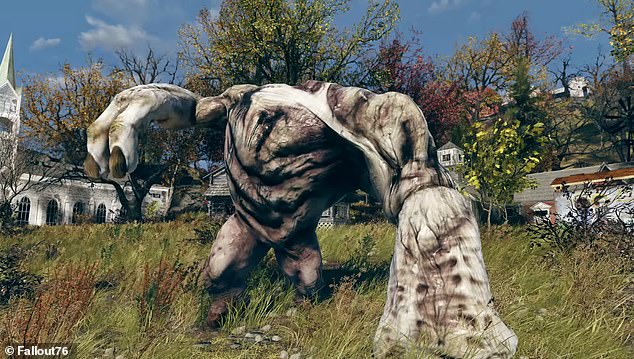Driving home at 11pm on a clear June night in 1964, local reporter Robert Cockrell saw something truly chilling along a road near Grafton, West Virginia.
In the car’s high beams, he glimpsed a massive, headless creature between seven and nine feet tall and roughly four feet wide, with smooth, seal-like skin that glistened in the moonlight.
Though terrified, he felt a duty to investigate and returned with two friends to search the area.
They found no trace of the creature itself, but the brush where it had appeared was mashed down, and a low, eerie whistling seemed to follow them along the river.
Over a hundred local teenagers soon took up the search, with more than twenty claiming they caught glimpses of the same headless figure.
Adults reported sightings as well, adding to Cockrell’s belief that something unexplained had occurred. The creature would eventually become known as the Grafton Monster, entering local lore alongside other West Virginia cryptids.
Cockrell, who reported for the Grafton Sentinel, described the creature in a letter from 1964: ‘It was between seven and nine feet tall, approximately four feet wide, and had a seal-like skin or covering which had a sheen to it.
‘It had no discernible head and did not move as I passed by. This is the only accurate description I can give since I was deeply frightened by the sight.’

Robert Cockrell described the creature as having a massive, headless creature between seven and nine feet tall and roughly four feet wide, with smooth, seal-like skin

The city has a population of just 4,729, and Mother’s Day was founded in Grafton in 1908
Grafton is a small town in Taylor County in the North Central region of the state.
It experienced its boom as a railway town between the mid-1850s and the first half of the 20th century. The city’s peak occurred around the 1920s before beginning a steep decline after World War II.
The current population is 4,500, but it was about double that in the 1960s when the Grafton Monster first appeared to Cockrell.
Despite his fear, Cockrell felt it was his duty to tell the story, though he worried that he would be labeled a hoaxer or dismissed as crazy. His editor ran the story, but with a cynical tone, attempting to suggest the sighting might have been boxes or some other mundane explanation.
In the weeks that followed, local curiosity exploded. Teenagers searched the woods and riverbanks, while police at the state, county, and local levels investigated briefly but found nothing.
Cockrell interviewed several teenagers individually, noting that their reports aligned with the details of his own sighting.
Over time, multiple adults also came forward with accounts of seeing the monster in varying locations along the river. These accounts helped cement the creature’s reputation in Grafton and beyond.
The Grafton Monster has been referred to by several names over the years.

The monster was spotted in 1964 by a reporter for the Grafton Sentinel

The legend has lived on for decades, with people creating artwork around the town based on what Cockrell saw
Initially called the Headless Horror, it later became the Beast of Grafton before settling into the now-familiar Grafton Monster.
Its legend is often mentioned alongside other cryptids from West Virginia, such as the Mothman of Point Pleasant, a winged, red-eyed figure; the Sheepsquatch, a large, white creature sometimes walking on two or four legs; and the Flatwoods Monster, a spade-headed being with glowing eyes said to emerge from a crashed craft.
Like Mothman, the Grafton Monster has taken on a life of its own in popular culture, including a depiction as a headless, deformed monster in the post-apocalyptic video game Fallout 76.
Over the years, sightings have been sporadic but persistent. In 2013, the creature was featured on the TV series Mountain Monsters, where filmmakers claimed the monster was able to pull bait out of a trap and escape with a bestial growl.
Some researchers have speculated that the Grafton Monster may be extraterrestrial or even an interdimensional visitor.
Despite these theories, local authorities have never seriously investigated the phenomenon.
George Dudding, in his book The Grafton Monster, explores the possibility that government agents, sometimes referred to as ‘Men in Black,’ visited those who claimed to see the creature, urging them to remain silent.
Dudding writes: ‘There is a tendency among law enforcement and military authorities to perpetrate cover-ups in situations of this type to prevent the spread of mass panic.
This seems to have taken place with the local law enforcement, the newspaper, and even city officials.’

Mother’s Day was founded in Grafton in 1908, with the city playing host to a shrine to Mother’s day
Cockrell himself, who passed away in 2022, allegedly retracted his sighting in a letter to a newspaper, suggesting that what he saw may have been exaggerated over time in conversations with friends.
He speculated that the creature could have been a local eccentric carrying boxes in the dark, though he never fully discounted the more mysterious explanations.
Grafton itself, with a population of just 4,729, has a long history of drawing visitors. The city played host to the founding of Mother’s Day in 1908 and is home to a shrine dedicated to the holiday.
Today, Grafton celebrates its most famous cryptid with the annual Grafton Monster Festival, drawing enthusiasts and tourists from across the country.
Yet, deep in the surrounding woods, the question remains: what exactly lurks out there?
The enduring mystery of the Grafton Monster lies not just in what was seen, but in what remains unseen.
It embodies the intersection of folklore, media, and human imagination, capturing the fascination of both locals and cryptid enthusiasts worldwide.
Whether a headless, seal-skinned creature, a misidentified eccentric, or a visitor from another world, the Grafton Monster remains a symbol of the unknown, a chilling reminder that some legends refuse to die.
This article was originally published by a www.dailymail.co.uk . Read the Original article here. .

